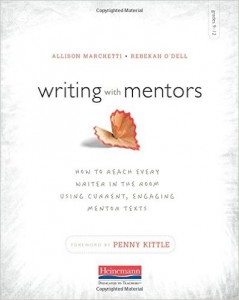Mentor Texts: Reading Like Writers
 Secondary teachers continue to switch from old units designed around novels, to new Common Core State Standards units focused on skills and genres. As they do so, an instructional method that can support this shift is the use of mentor texts to “read like a writer.”
Secondary teachers continue to switch from old units designed around novels, to new Common Core State Standards units focused on skills and genres. As they do so, an instructional method that can support this shift is the use of mentor texts to “read like a writer.”
When a class reads like a writer, the teacher takes a descriptive approach, rather than a prescriptive approach, to instruction. It might help to think of this as an inquiry-based lesson. Instead of a teacher saying to her students, “Your essay must contain a thesis statement that sounds like this,” she might guide her students as they read another text, asking questions like, “When in this paragraph does this writer tell us what claim he’s making? How does he do it?”
It is clear that the secondary ELA world is catching on to this instructional method. It’s deeply rooted in our Common Core State Standards. Rather than requiring just the comprehension of texts, our anchor standards require students to analyze texts for word choice, structure, or “how purpose shapes the content and style of a text” (R.6). This analytical reading goes hand-in-hand with the descriptive approach taken when classes are reading like writers.
As our state makes the switch from ACT to SAT, the focus on analysis is even more apparent. The Teacher Implementation Guide produced by the College Board includes in its recommended instructional strategies the direction to “ask students to investigate the ways authors use word choice, structure, and other techniques….” Likewise, the new SAT essay does not simply ask that students be able to write their own persuasive essays; it requires that they analyze another writer’s argument.
A Book Focused on High School
It’s clear that this inquiry-based approach to reading and writing is profoundly important to secondary teachers. This is an enormous instructional shift for many teachers, especially for those in high schools. As they tackle new units and new assessments, they’ll need support. Some of our go-to mentors like Kelly Gallagher and Jeff Anderson have been writing about this instructional method, but the vast majority of writing that’s been done around mentor texts has focused on elementary classes.
 That’s why it’s so exciting to see the recent publication of Writing with Mentors, by Allison Marchetti and Rebekah O’Dell. So many other great mentor-text resources have left secondary teachers like myself to adapt the work for my high school students. But this book is written by two teachers with a decidedly high-school lens.
That’s why it’s so exciting to see the recent publication of Writing with Mentors, by Allison Marchetti and Rebekah O’Dell. So many other great mentor-text resources have left secondary teachers like myself to adapt the work for my high school students. But this book is written by two teachers with a decidedly high-school lens.
As the authors put it in their introduction, “This book was written to help you understand the potential that writing with mentors has for your students.” The book starts with the writers’ understanding of the use of mentor texts. Throughout the subsequent chapters, the book transitions to students’ understanding, use, and ownership of mentor texts.
The first two chapters offer the most foundational support for high school teachers who are making the paradigm shift, from prescriptive instruction to reading like a writer. These early chapters outline the classroom essentials needed to foster this instructional approach. The authors describe creating conditions, space, and time for reading and writing, as well as the concept of choice.
The second chapter digs into how teachers should approach the planning and internalization of this method, or as the authors call it, “Developing a Mentor Text Habit of Mind.” This chapter offers concrete suggestions for the finding and building of mentor-text collections, as well as for storage, organization, and planning. It is essential reading for secondary teachers who are just starting to get their toes wet in this kind of analytical reading and writing.
A Book for Novices and Veterans
The subsequent chapters focus on how to use mentor texts throughout the writing process, from planning to publishing. Throughout the book, the authors include plenty of resources to support teachers at all levels of understanding. Included in these resources are examples of texts that the authors have used as mentors for various genres and purposes. These texts are explained throughout the chapters and again collected in an appendix, complete with URLs and QR codes for quick access.
I’ve only had this book since its publication this fall, but with all of my highlighting, markings in the margins, and sticky notes, it’s already looking pretty well loved. It seems like every time I turn around, I’m recommending it to someone new.
That’s because whether you’re a teacher who has been using mentor texts for years, or one who is just starting to grapple with the new units and standards, this book offers valuable support for a trusted instructional approach, one that’s guaranteed to help our students grow as analytical readers and writers.
Resources
Gallagher, K. (2011). Write Like This: Teaching Real-World Writing Through Modeling & Mentor Texts. Portland: Stenhouse.
Gallagher, K. (2014). Making the Most of Mentor Texts. ASCD , 28-33.
Marchetti, A., & O’Dell, R. (2015). Writing with Mentors: How to Reach Every Writer in the Room Using Current, Engaging Mentor Texts. Portsmouth: Heinemann.
Ray, K. W. (1999). Wondrous Words: Writers and Writing in the Elementary Classroom. Urbana: National Council of Teachers of English.
 Megan Kortlandt (@megankortlandt) is a secondary ELA consultant and reading specialist for the Waterford School District. In the mornings, she teaches AARI and literacy intervention classes at Waterford Mott High School, and in the afternoons, she works with all of Waterford’s middle and high school teachers and students in the Curriculum, Instruction, and Assessment department. Additionally, Megan works with Oakland Schools as an instructional coach for AARI. She has presented at various conferences including the Michigan Council for Teachers of English and Michigan Reading Association annual conferences.
Megan Kortlandt (@megankortlandt) is a secondary ELA consultant and reading specialist for the Waterford School District. In the mornings, she teaches AARI and literacy intervention classes at Waterford Mott High School, and in the afternoons, she works with all of Waterford’s middle and high school teachers and students in the Curriculum, Instruction, and Assessment department. Additionally, Megan works with Oakland Schools as an instructional coach for AARI. She has presented at various conferences including the Michigan Council for Teachers of English and Michigan Reading Association annual conferences.
